Image Archive



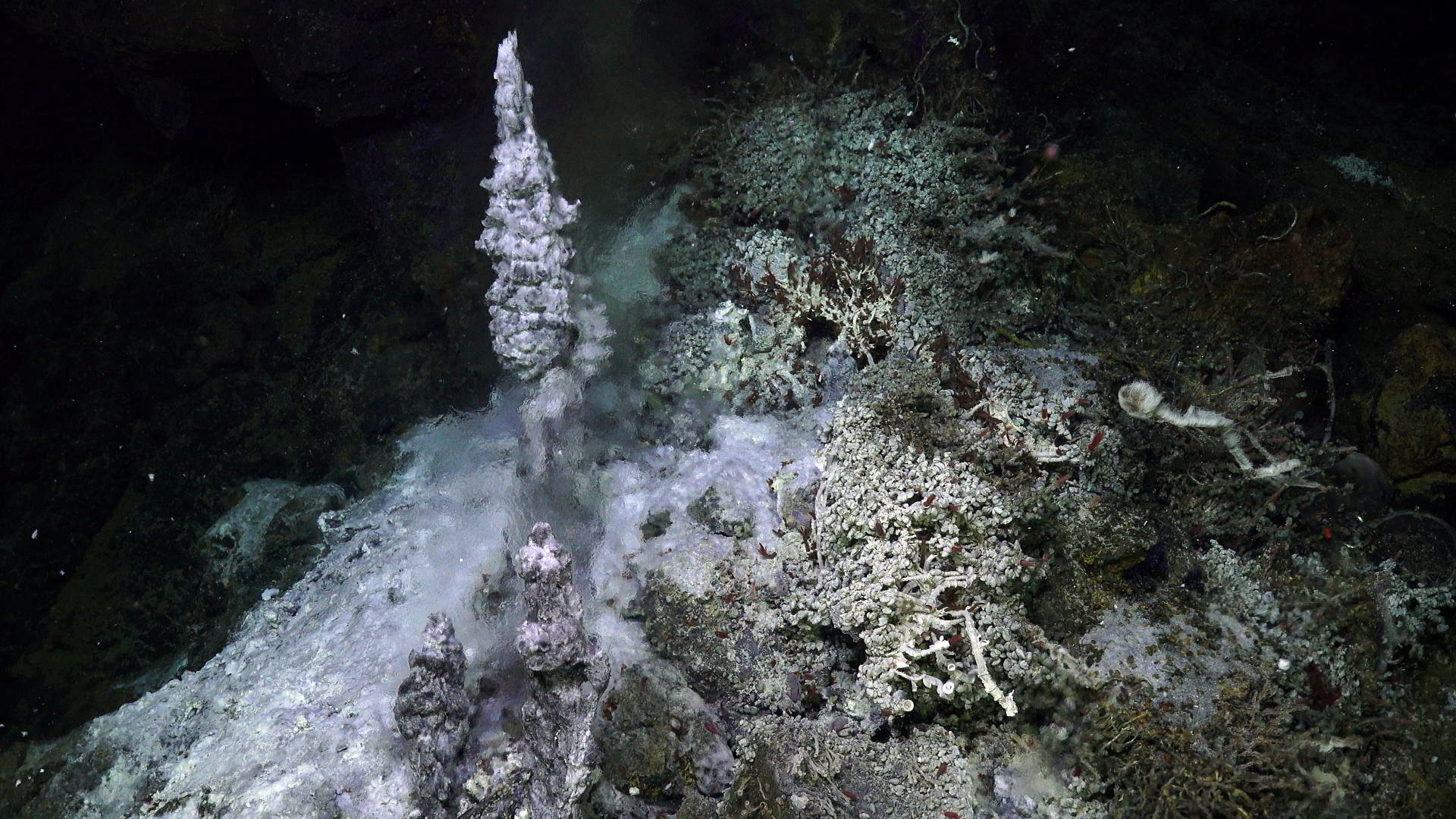


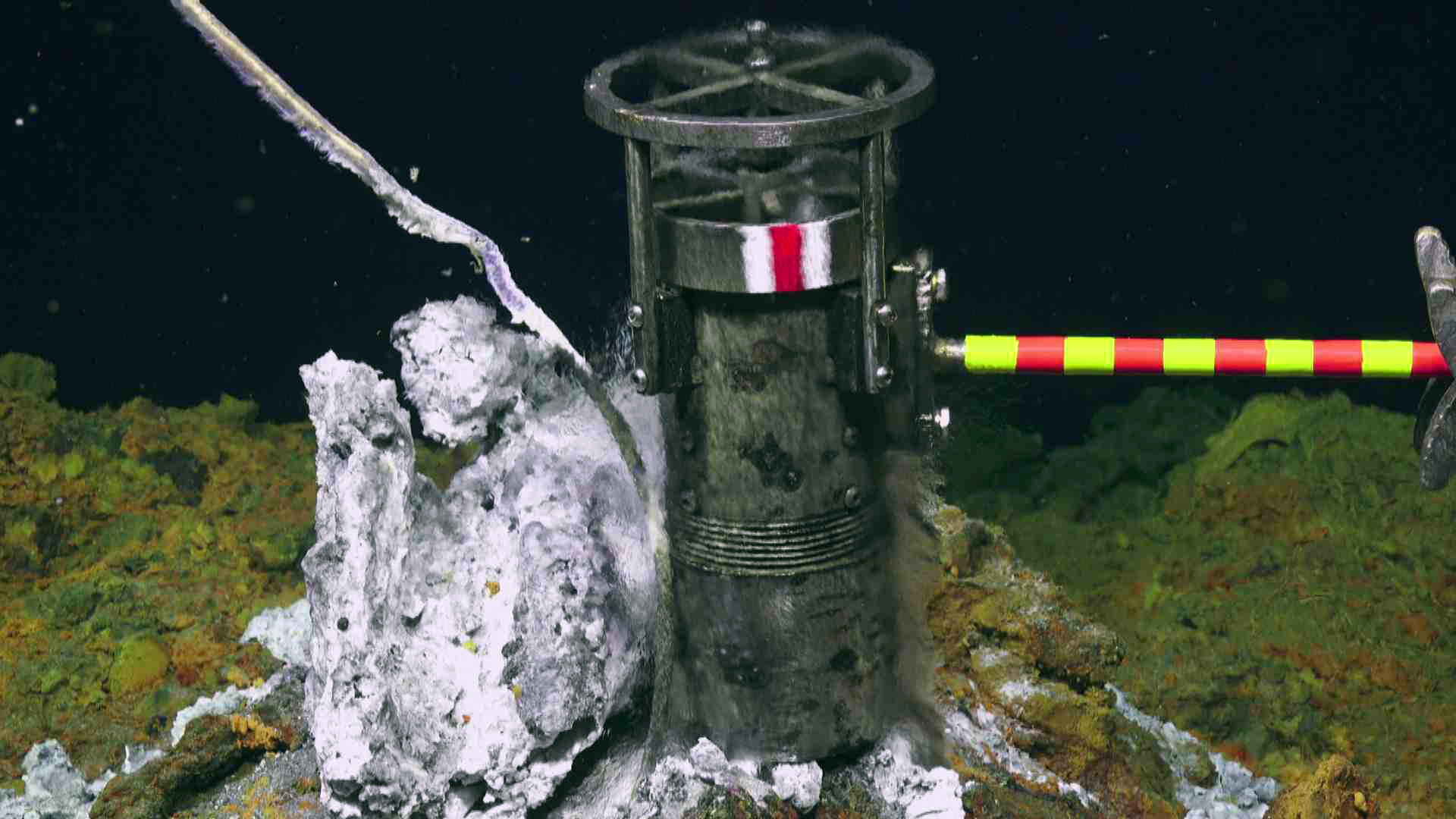




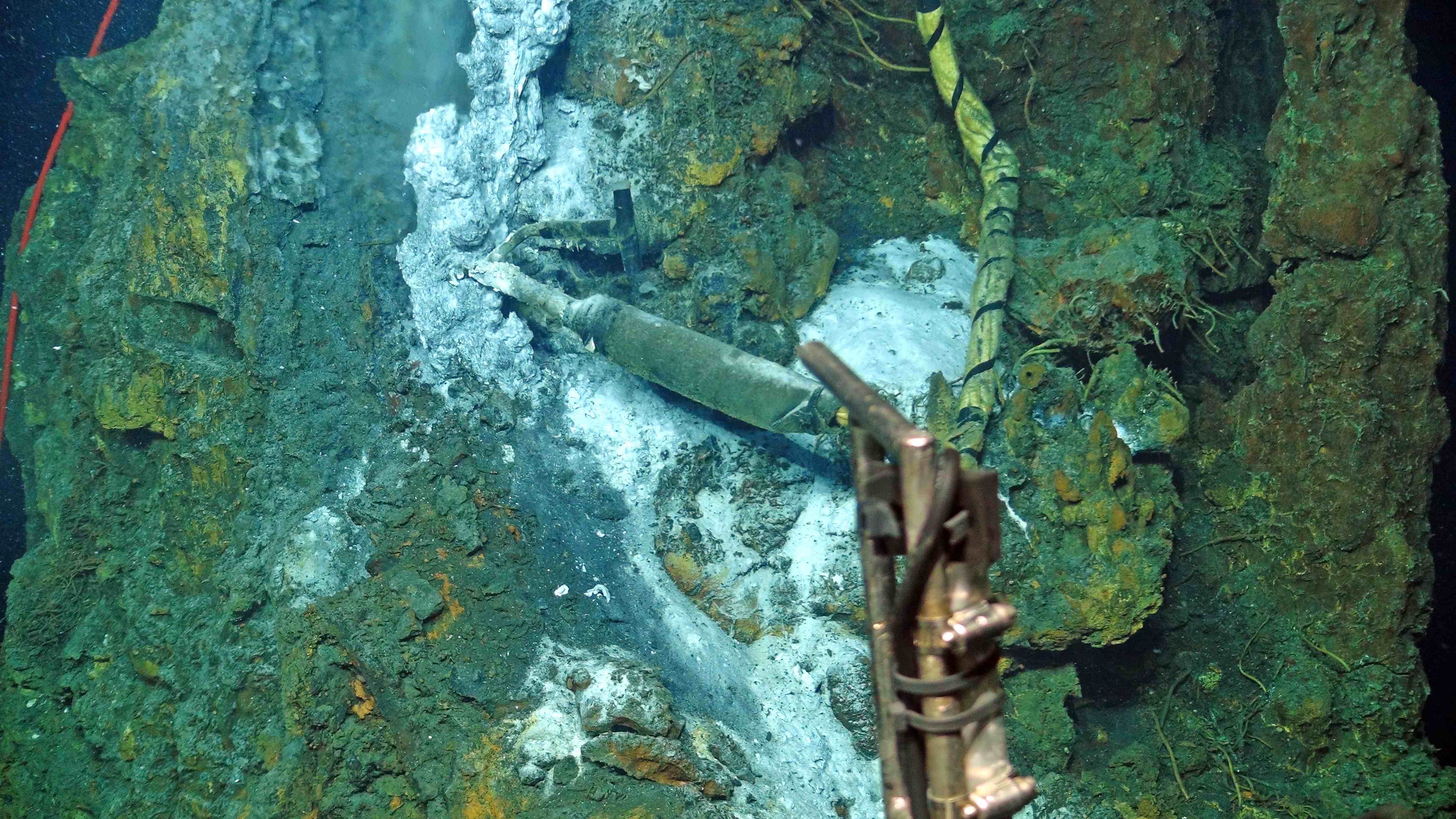











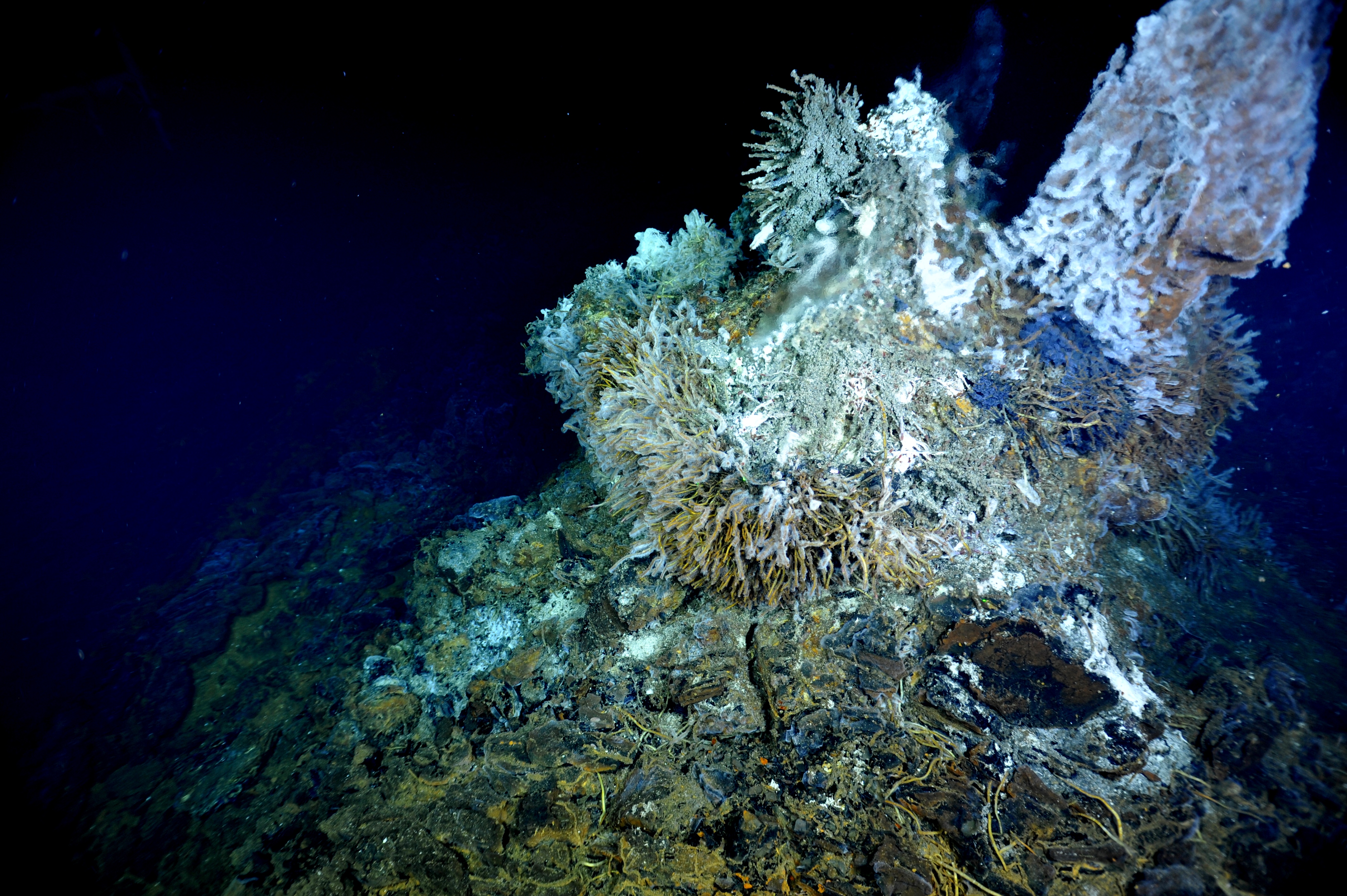

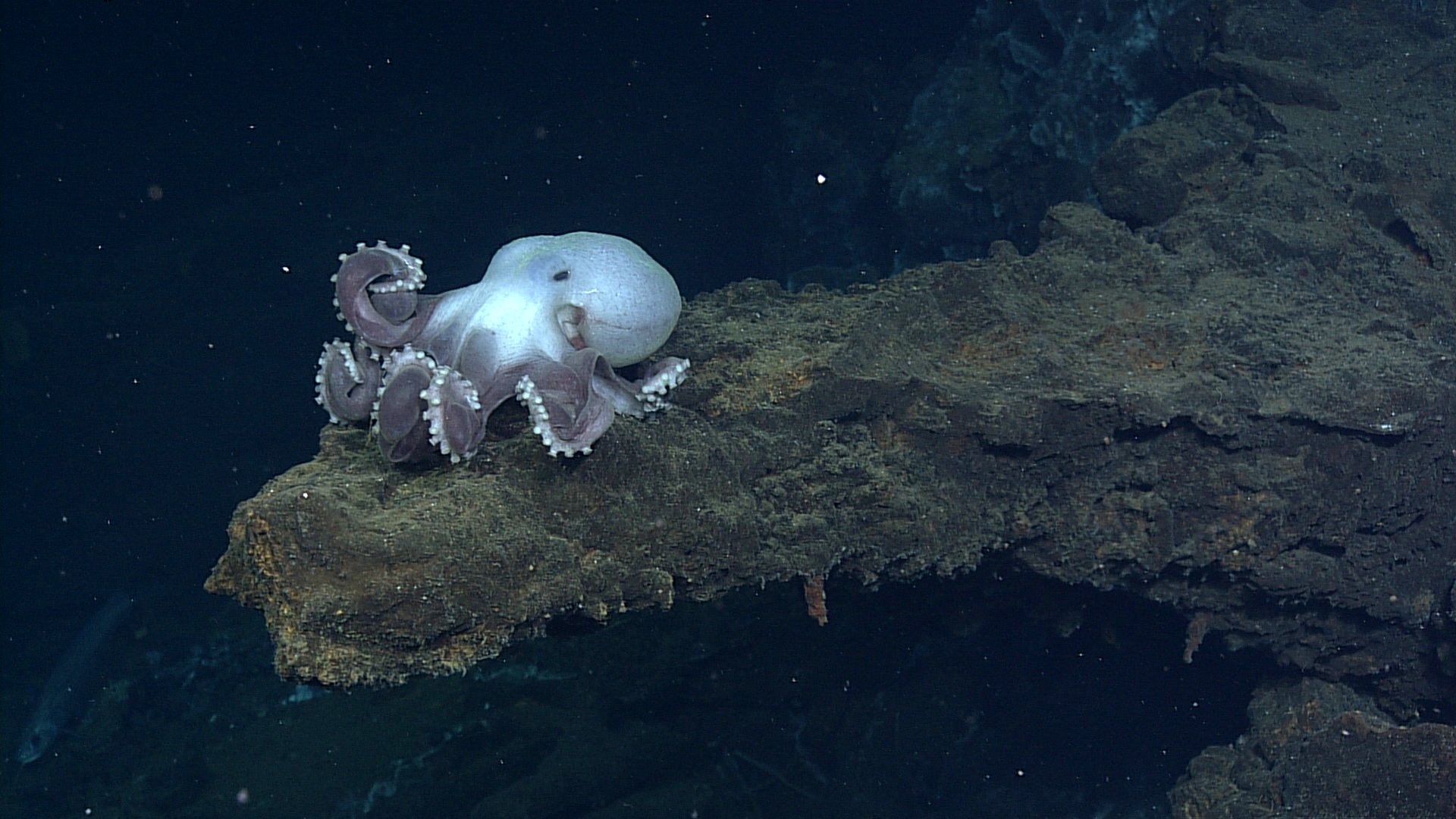



Inside the ROV Jason control van working at the International District hydrothermal field, nearly a mile beneath the surface. Credit. S. Karaduzovic, University of Washington.

A spider crab explores a small collapse pit floored by glass lava talus on the summit of Axial Seamount. Credit: UW/NSF-OOI/WHOI: V20.

A spider crab hangs upside down exiting a glassy collapse zone. Credit: UW/NSF-OOI/WHOI: V20.

The and anhydrite-rich chimlet "Castle" rises from the seafloor. Credit: UW/NSF-OOI/WHOI:V20.

The digital still camera at the Tiny Village site is covered in filamentous bacteria after a year-long deployment. Credit: UW/NSF-OOI/WHOI. V20.

Near the summit of the ~16 m-tall El Guapo chimney, sulfide worms, and tubeworms colonize the younger part of the new sulfide growth. Credit: UW/NSF-OOI/WHOI, V18.

A flow meter for hydrothermal vents is deployed at the small Diva chimney, held in the arm of Jason. Here, fluids are issuing the anhydrite-rich structure at ~ 290°C. The flow meter was designed by Leonid Germanovich, Clemson University. Credit: UW/NSF-OOI/WHOI, V18.

Every year when we are diving in the International District Hydrothermal Field, very large fish, ~ 4 feet! in length come to investigate what we are doing. They swim slowly in the 2.4°C waters. Credit: UW/NSF-OOI/WHOI, V18.

A titanium isobaric gas-tight sampler (IGT) is used to sample fluids with dissolved gases in a high temperature vent on the El Gordo metal sulfide chimney located in the International District Hydrothermal Field at ~ 1500 m water depth on Axial Seamount. The base of the cabled RAS fluid sampler and microbial DNA sampler mooring is in the background. Credit: UW/NSF-OOI/WHOI; V16.

The cabled digital still camera streams images of Jason (Dive J2-932) live back to shore in real time as the vehicle works at the active hydrothermal vent called 'El Gordo' in the International District Hydrothermal Field - depth is 1500 m, and >300 miles offshore. The hydrothermal fluid sampler, called the RAS, is shown to the left, which allows fluid samples and temperature to be taken for a year. The instrument can be run in "mission mode" where samples are preprogrammed, or in "sponse mode" where missions are interrupted by operators to take samples - such as was done during the eruption of Axial Seamount in 2015. Credit: UW/OOI-NSF/WHOI, V16.

A Hydrothermal Vent Cap at the top of the actively venting chimney called ‘El Gordo’, traps high temperature hydrothermal fluid. An intake nozzle from the mass spectrometer allows measurement of gas chemistry in real-time, sending data at the speed of light back to shore. Another nozzle sucks in vent fluids for sampling and for filtering of microbial DNA: the samples fluids and DNA are recovered during annual Cabled Array maintenance cruises for follow-on shore-based analyses. Credit: UW/NSF-OOI/WHOI; Dive J2-912, V16.

The wand of the temperature and resistivity sensor is embedded in 1-year old metal sulfide and sulfate minerals precipitated from hot hydrothermal fluid. This novel instrument, built by M. Lilley at the University of Washington, measures real-time changes in fluid temperature and resistivity as an analogue for chlorinity. Boiling vents often emit low-salinity, low pH fluids. Credit: UW/NSF-OOI/WHOI; Dive J2-912, V16.

Close up of the Remote Access Fluid Sampler (RAS) built by D. Butterfield at NOAA-PMEL-UW. A nozzle is installed in an active venting site on the El Gordo chimney. Controlled from shore, or by a mission plan, a pump sucks in hydrothermal fluid into sterile bags (and also onto filters for collection of DNA in a similar system above the RAS). During annual Cabled Array maintenance cruises, this coupled mooring is recovered and collected material analyzed, with results provide at oceanobservatories.org. Credit: UW/NSF-OOI/WHOI; Dive J2-212, V16.

A temperature probe (HOBO) installed by NOAA last year in the hydrothermal vent ‘Diva’ is now enclosed in the sulfate-rich, white mineral called anhydrite. The high temperature fluids at this site host very high concentrations of carbon dioxide being outgassed from the underlying magma chamber. Credit: UW/OOI-NSF/WHOI; Dive J2-912, V16.

A digital still camera (left), mass spectrometer (middle) and hydrothermal fluid and microbial DNA sampler (right) document changes in animal life, gas and fluid chemistry, temperature, and chimney growth at the El Gordo vent site in the International District Hydrothermal Field at the summit of Axial Seamount - water depth is ~ 5000 ft (1500 m). Data are streaming live to shore 24/7. Credit: UW/OOI-NSF/WHOI, V16.

A small, 1-day old chimlet sprouts from the 280°C, gas-rich vent called Dive in the International District Hydrothermal Field. Credit: UW/NSF-OOI/CSSF; ROPOS Dive R1839; V15.

A huge rattail, ~ 5 feet in length, swims slowly in front of the ROV ROPOS near the International District Hydrothermal Field at a depth of 5000 ft beneath the ocean's surface. This area has a higher abundance of these fish than observed elsewhere in the caldera, perhaps because of the larger size of the vent field and hence food source. Credit: UW/NSF-OOI/CSSF; ROPOS Dive R1729; V15.

During ROPOS Dive R1729, a digital-still camera (left), a mass spectrometer (middle) and a fluid- and microbial-DNA sampler (right) were installed in the International District Hydrothermal Field at the vent called El Gordo. A titanium 'hat' rests on top of the structure in a tubeworm and limpet patch. Inside the hat are temperature probes and intake nozzles for the fluid and DNA sampler. Credit: UW/NSF-OOI/CSSF; ROPOS Dive R1729; V14.

A current meter is held in the manipulator of the ROV ROPOS for installation at the International District 2 Site. Photo credit: NSF-OOI/UW/CSSF; Dive 1723; V14.

A bottom pressure-tilt instrument is installed at the summit of Axial Seamount in the International District hydrothermal field. This instrument measures the rise and fall of the seafloor due to melt migration in the subsurface. Currently, the seafloor is rising and this is believed to reflect the influx of magma into the core of the volcano.The instrument rests on a frozen lava flow - called a sheet flow. The small black marble in the yellow plate at the instrument base indicates that the platform it level. Photo credit: NSF-OOI/UW/CSSF; Dive R1723; V14.

A short-period seismometer was installed and connected to a junction box in the International District hydrothermal field at the summit of Axial Seamount. Photo credit: NSF-OOI/UW/CSSF; Dive R1719; V14.

A beautiful octopus sits atop a ledge at the base of the hydrothermal vent called Escargot in the International District hydrothermal vent field at Axial Seamount. Credit: UW/NSF-OOI/CSSF; ROPOS Dive R1719; V14.

On July 20, the medium-powere junction box MJ03C was installed in the International District hydrothermal vent field on ROPOS Dive R1717. It was connected to a ~2300-m-long cable (RSO3W6) that will connect this system to Primary Node PN3B. A temperature-resistivty sensor (TRHPHA301) is inside the J-Box, awaiting installation during a follow-on dive. Photo credit: NSF-OOI/UW/CSSF; Dive 1717; V14.

El Gordo, at International District, is a site for Regional Cabled Array instrumentation in 2014. Brown tubes are stressed tubeworms covered in filamentous bacteria. Credit: UW/NSF-OOI/CSSF; ROPOS Dive R1719; V14.

Ciliates, purple single-celled Protists, colonize the base of Escargot hydrothermal vent. Credit: UW/NSF-OOI//CSSF; ROPOS Dive R1719; V14.

The large pink octopus (likely Muusoctopus sp.) sits on a ledge at Escargot hydrothermal vent in the International District Hydrothermal Field. Credit: UW/NSF-OOI/CSSF; ROPOS Dive R1719; V14.

Medium-Power Junction Box MJ03C rests on the platform for ROPOS, awaiting connection to the underbelly of ROPOS. This node was installed on the seafloor during dive R1717.

The ROV ROPOS has an RSN-OOI , medium-powered junction box, MJ03C, secured to its underbelly for transport to the International District hydrothermal vent field. The junction box will provide power and communication to a diverse suite of chemical, temperature, and biological sensors, in addition to a digital still camera. Photo credit: NSF-OOI/UW/CSSF; Dive R1717; V14.
- Anemone
- Animal
- Arthropod
- ASHES
- Axial
- Axial Base
- Axial Biology
- Axial Caldera
- Bacteria
- Basalt Lava
- BEP
- Biofouling
- biolgoy
- Biology
- Camds
- Camera
- Camhd
- Central Caldera
- Ciliates
- Cnidaria
- Coastal Biology
- Crab
- Deep Profiler Mooring
- Dive Highlights
- Eastern Caldera
- Echinoderms
- Endurance Array
- Engineering Team
- ENLIGHTEN 10
- Exploratorium
- Fish
- Geology
- HD Camera
- HPIES
- Hydrate Ridge
- Hydrates
- Hydrophone
- Hydrothermal Vents
- Illustration
- Inshore 80 Meters
- Instrument
- International District
- J-BOX
- Jason
- Jellyfish
- Junction Box
- K12
- Lava
- Mollusk
- Moorings
- Nodes
- Nudibranch
- Octopus
- OOI
- Oregon Offshore
- Oregon Offshore 600 m
- Oregon Shelf
- Oregon Slope Base
- People
- PN1B
- PN1D
- Polychaetes
- PPSDN
- Primary Node
- RASFL
- ROCLS
- ROPOS
- ROPOS Dives
- ROV Team
- RV Revelle
- RV Sikuliaq
- RV Thompson
- Salp
- Sample
- SC13
- Science Team
- Sea Cucumber
- Sea Star
- Sea Urchin
- Seafloor
- Seismometer
- Sensors
- Shallow Profiler Mooring
- Shark
- Shipboard
- Shore Station
- Slope Base
- Smoker
- Soft Coral
- Southern Hydrate Ridge
- Sponge
- Squid
- Students
- Students & Guest Participants
- Tmpsf
- Tubeworms
- VISIONS 11 Leg 1
- VISIONS 11 Leg 2
- VISIONS 11 Viewers
- VISIONS 13
- VISIONS 14
- VISIONS 15
- VISIONS 16
- VISIONS 17
- VISIONS 18
- VISIONS 20
- VISIONS 22
- VISIONS 23
- Visualization
